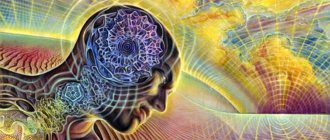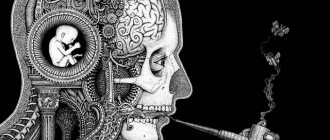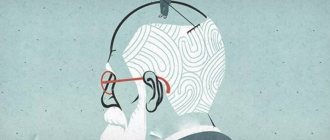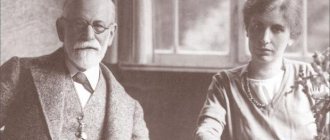Nowadays all kinds of aphorisms about the meaning of life are in fashion. Here are some of the most popular:
“The more perfect a person is on the outside, the more demons he has inside.” “The only person you should compare yourself to is your past self. And the only person you should be better than is you now.” “A person never gives up anything, he simply replaces one pleasure with another.”
But, putting these beautiful phrases in statuses, publishing them on social networks, quoting them in companies, most people do not even realize that they belong to the famous psychologist of the first half of the 20th century, Sigmund Freud, and reflect the whole essence of his teaching, known as psychoanalysis.
What is psychoanalysis
Psychoanalysis is a psychotherapeutic direction created by Freud, an effective method of treating various mental disorders that has gained wide popularity.
This is the first direction in psychology and psychotherapy, worked out in detail in terms of theory. Two hypostases of a person’s personality are clearly described - the unconscious (hidden, repressed, unconscious) and the conscious (superficial, visible, conscious, understandable). They constantly come into conflict with each other - hence the internal conflicts that ultimately lead to mental disorders. But the most important thing is that the unconscious almost always wins. It is this that becomes the motivator of most actions and decisions. The task of psychoanalysis is to open it and transfer it to the plane of consciousness.
Being a key concept, personality in psychoanalysis is maximally represented from the point of view of both hidden and conscious motives that determine its development and improvement throughout life.
What does this direction study? The subject of the study is hidden motives from the unconscious that provoke the development of various psycho-emotional disorders of personality and behavior. They are revealed through the free flow of thoughts expressed by the analysand (patient).
Today, the psychoanalytic direction is represented by different schools. But they are all united by basic concepts - the division into the conscious and unconscious and the search for the origins of problems in childhood. In psychology, this is a powerful tool for eliminating unconscious mechanisms and habitual patterns that interfere with the realization of desires and social adaptation.
Basic concepts and ideas of Freudianism
Psychoanalysis
(from the Greek psyche - soul and analysis - decision) - part of psychotherapy, a medical research method developed by S. Freud for diagnosing and treating hysteria. Then it was reworked by Freud into a psychological doctrine aimed at studying the hidden connections and foundations of human mental life.
This doctrine is based on the assumption that a certain complex of pathological ideas, especially sexual ones, is “repressed” from the sphere of consciousness and operates from the sphere of the unconscious (which is thought of as the area of domination of sexual aspirations) and under all sorts of masks and vestments penetrates consciousness and threatens spiritual unity I, included in the world around him.
In the action of such repressed complexes
“they saw the cause of forgetting, slips of the tongue, dreams, false actions, neuroses (hysteria), and they tried to treat them in such a way that during a conversation (“analysis”) it was possible to freely evoke these complexes from the depths of the unconscious and eliminate them (through conversation or appropriate actions), namely to give them the opportunity to react.
Proponents of psychoanalysis attribute sexual (“ libido
") a central role, considering human mental life as a whole as a sphere of dominance of unconscious sexual desires for pleasure or displeasure.
From the history
Freud
The founder of psychoanalysis is Sigmund Freud (1856-1939), a famous Austrian psychologist, psychiatrist and neurologist. Practicing in different hospitals, he gradually accumulated experience in order to later formalize it into one clear and well-founded theory.
- For a long time he worked with patients suffering from neurotic and hysterical character traits.
- Then he consulted aphasic children (with speech impairments). He revealed that their problems are not caused by physiology, but by mental reactions.
- He completed an internship with the famous neurologist J.-M. Charcot, studying general paresis.
As a result of his extensive and varied practice, in 1895 he wrote the book “Studies in Hysteria.” This is the first theoretical basis of psychoanalysis. It is in it that the idea is formulated that the causes of most mental disorders are suppressed, hidden in the unconscious memories of traumatic situations from childhood. Here Freud suggested that they are all somehow connected with sexual desires.
In 1900, his second major work, “The Interpretation of Dreams,” was published. It describes the meaning of dreams for the human psyche. In his opinion, it is they who reveal the essence of the unconscious, which manifests itself in the form of symbols. They just need to be decrypted. The same book presents a detailed “topographic model of the psyche,” its structure and operating principle. According to her, social prohibitions and educational frameworks displace indecent sexual desires into the realm of the unconscious. This process almost always ends with a feeling of increased anxiety and the development of mental disorders.
Sigmund Freud (1856-1939)
Freud's psychoanalysis (Freudianism) subsequently constantly developed, expanded and was critically rethought. On its basis, new schools, trends and branches from classical theory appeared. Most often they were led by former colleagues and students of Freud. For example, A. Adler and K. G. Jung. Although on many issues they sharply disagreed with their teacher.
Jung
Many experts note that Jung's psychoanalysis is a direction radically different from Freudianism. Carl Gustav Jung (1875-1961) was a Swiss psychiatrist and teacher who developed the doctrine of archetypes. These are structural elements of the collective unconscious (there are archetypes of the baby, maiden, mother, rebirth, spirit, trickster, etc.). With their help, you can interpret not only dreams, but also myths of different nations. The goal of Jung's direction (as defined by the psychoanalyst himself) is the individuation of the individual. This is a process of mental development when individual abilities (talents) and unique characteristics of a person are fully realized.
Jung's concept of psychological types has gained particular popularity. The classification is based on psychological attitude (extroverted or introverted) and mental functions (thinking, feelings, sensations, intuition).
Neo-Freudianism
The second, later wave of the emergence of new psychoanalytic movements is neo-Freudianism. The most prominent representatives are E. Fromm, K. Horney, G. S. Sullivan, J. Lacan and others. They tried to find common points of contact between psychoanalysis and the social and human sciences.
Erich Fromm (1900-1980) - German sociologist, social psychologist, philosopher, representative of the Frankfurt School. He is the founder of neo-Freudianism and Freudo-Marxism. Linked Freud's psychoanalysis with Marxism and ethics.
Karen Horney (1885-1952) was an American psychologist and a key figure in neo-Freudianism. Shifted the emphasis from sexual desires as the main motivators of human behavior to the impact of the surrounding social environment. She outlined her views and ideas in the book “New Paths in Psychoanalysis.”
In Russia
In Russia, this trend became incredibly popular in the 1920s. Ivan Dmitrievich Ermakov (1875-1942) was a Russian psychiatrist and psychologist, who was also an artist and literary critic. Considered a pioneer of Freudianism in the USSR. He founded the State Psychoanalytic Institute and translated the works of Freud and Jung into Russian. Since the 1930s. psychoanalysis was persecuted and forgotten until the 1990s.
Modern psychoanalysis has more than 20 schools and movements. Their theories and approaches to treating disorders differ so radically that it is extremely difficult to find one source for them.
E. Fromm and his concept of “existential dichotomy”
The German philosopher and psychoanalyst E. Fromm, a follower of Freud's teachings, introduced the concepts of existentialism, as well as Marxism, into psychoanalysis. He formulated his concept in the book “The Soul of Man.” The concept of “existentialism” can be defined as a philosophy of survival that stands on the duality of human essence. Dichotomy is a bifurcation, a gradual division into two entities, the internal connection of which is more noticeable than the external one. An example is a person who is essentially a biological being, but the presence of reason in him takes him out of this circle, makes him a stranger in the natural world, separates him from nature.
The philosophy of existentialism and psychoanalysis is, according to Fromm’s definition, humanistic psychoanalysis, designed to study a person’s personality from the point of view of the relationship between him and society, namely, a person’s attitude towards himself, the people around him and society.
Fromm attached great importance to love. He argued that the emergence of a feeling, its development, changes a person, makes him better, reveals hidden depths in him, qualities that can ennoble him, raise him to unprecedented heights. It manifests responsibility for another, a feeling of attachment to a loved one, to the whole world. This leads a person from harmful egoism to humanistic feelings and altruism.
Kinds
Classic Freudianism
The basic concept in a nutshell: any mental disorder is the result of a conflict between the unconscious (formed under the influence of psychosexual development) and the conscious (dictated by upbringing and social norms).
Jungian psychoanalysis
Another name is analytical (complex) psychology. The goal is to comprehend and integrate the deep forces and motivations of human behavior through the phenomenology of not only dreams (as in Freud), but also folklore and mythology. The key concept is the collective unconscious.
Statistical
Olga Pertseva’s author’s technique, based on the square (psychomatrix) of Pythagoras. Allows you to create a digital portrait of a person, uncomplicated by society’s patterns imposed by patterns of thinking and behavior. One of the directions in numerology.
Existential
The technique of existential psychotherapy developed by J.-P. Sartre. According to her, a person is a complete integrity, and not a complex of behavior patterns that come into conflict with sexual instincts (as with Freud). The main tool is observation.
Humanistic
The founder is Fromm. Denies the leading role of sexual desires in personality development. Focuses attention on other factors of its formation - sociological, political, economic, religious and cultural.
Structural
The founder is J. Lacan. A direction that uses the special meaning of language to characterize the unconscious. It is actively used for the treatment of speech disorders caused by mental disorders and childhood trauma.
Ego psychology
The leading role in the psyche is assigned to the Ego (according to the classical concept, it was played by the Id). Representatives: A. Freud (the youngest daughter of Sigmund Freud), E. Glover, E. Erikson.
Object Relations Theory
The basis of the British school of psychoanalysis. The basic idea is that people’s attitudes towards the world around them in adulthood are formed under the influence of experiences in childhood. The main representatives are M. Klein and D. Sandler.
Modern schools with a psychoanalytic approach to the treatment of disorders are also Kohut's Self psychology, Sullivan's interpersonalism and Stolorow's intersubjectivism.
Theory
An analysand is a patient with whom a psychoanalyst works.
Metapsychology is the entire theory of psychoanalysis.
Topographic model of the psyche:
- conscious - its superficial, understandable, visible part;
- unconscious - hidden, incomprehensible, mysterious, unconscious;
- preconscious - borderline, located in the area of the unconscious, but breaking out during certain situations of choice or in dreams.
Structural model of the psyche:
- Id (It) - instinct, obeys the principle of pleasure;
- Ego (I) - contact with the outside world through perception, controls behavior and thinking;
- Superego (Super-I) - moral norms, values based on moral prohibitions and formed in the process of education.
Personality structure according to S. Freud
Stages of psychosexual development - experience that leaves an imprint in the form of moral attitudes, character traits, behavior patterns:
- Oral phase (from birth to 1.5 years) - dominance of the id.
- Anal (1.5-3.5) - the formation of the super-ego under the influence of norms, rules, restrictions, prohibitions.
- Phallic (3.5-6) - increased interest in sex, which most often leads to Oedipus or Electra complexes.
- Latent (6-12) - absence of manifestations, break.
- Genital, adult (from 12 years old).
A protective psychological mechanism is an unconscious mental process aimed at eliminating negative experiences:
- substitute;
- compensatory;
- displacing;
- denying;
- projecting;
- sublimating;
- rationalizing;
- retrogressive.
These are the basic defense mechanisms described by Freud. Today the list has been significantly expanded and includes more than 30 mental processes.
Two stages in the philosophical activity of S. Freud
Medical practice and observation of patients gave the scientist a large amount of information for reflection. On its basis, work was carried out that formed certain views on the issues of psychoanalysis of S. Freud - a philosophy with certain aspects that can be divided into two stages. The first is the formation of the concept of the unconscious, its duration lasted from 1900-1920. The second lasted until the end of his life. It is at this stage that the unconscious is explored, including the instinctive cosmic urges of life and death.
Basics
Key points:
- human behavior, knowledge of the surrounding world and experience are determined by internal drives;
- they are irrational and unconscious;
- attempts to understand them cause psychological resistance, which manifests itself in the form of defense mechanisms;
- individual characteristics of behavior and personality depend on events that occurred in early childhood, at different stages of psychosexual development;
- conscious perception of the surrounding world and the material of the unconscious (repressed) come into conflict with each other;
- it leads to various psycho-emotional disorders: neuroses, depression, neurotic character traits, phobias;
- You can free yourself from the area of the unconscious if you become aware of it (but this can only be done with the help of a professional).
These are the basic ideas of psychoanalysis on which work with the patient is based.
Three components of the structure of the psyche
If we briefly outline Freud's philosophy of psychoanalysis, it should be noted that the human psyche has three structures that can be characterized as:
1. Unconscious (It). This layer of the psyche is inherited by a person from distant ancestors. It is in it that two basic human instincts are found:
- Procreation is sexual attraction and energy, or, according to Freud’s definition, libido.
- Self-preservation. Determines aggressive behavior.
The unconscious, according to Freud's definition, is beyond the limits of the rational, in other words, it is irrational and immoral (immoral).
2. Subconscious (I). Formed on the basis of life experience. The “I” intelligently, and in accordance with reality, tries to translate the unconscious “It” into conformity with the moral principles of the “Super-ego”. Its goal is to limit the reflex impulses of the “It” in accordance with the current requirements of the reality in which a person is located.
3. Consciousness (Super-I). It can be defined as the conscience or judge who controls and punishes the unconscious “It”. It is in it that all the norms of morality, morality, and all human ideals are concentrated.
Moreover, each component lives its own life and does not depend on the others. Even if we briefly get acquainted with the philosophy of psychoanalysis, we can conclude that consciousness is violence against natural instincts.
Practice
General treatment regimen
The analysand verbalizes (pronounces) thoughts based on free associations that arise in his head, as well as fantasies and dreams.
Next, the psychoanalyst, based on this material, finds unconscious conflicts that are the causes of all the problems of the analysand.
He eventually interprets them to find a way to solve problems.
Examples from Freud's private practice
In his works, Freud described in detail not only the theory of psychoanalysis, but also the clinical cases that he himself encountered. There are 43 of them in total, but 5 of them are the most famous. They demonstrate how psychiatrists should tailor their sessions depending on the diagnosis they are dealing with.
The psychoanalytic approach is effective for diagnoses such as:
- alarming and conversion hysteria;
- obsessive-compulsive neurosis;
- psychoneurotic depression;
- neurotic character traits;
- phobias;
- psychosomatics.
Contraindications are various forms of schizophrenia and manic-depressive psychosis. The psychoanalytic approach to the treatment of impulsive neurosis, perversion, addictions and deviant behavior is decided on an individual basis.
Methods of psychoanalysis
Free associations
Is the basic rule of psychoanalysis. The projective method consists in asking the analysand to freely say whatever comes to mind. At the same time, he can even express what seems absurd and obscene to him. The task of the psychoanalyst is to see in this stream of thoughts, isolate and analyze the unconscious, and connect it with the patient’s childhood and dreams.
Dream interpretation
The analysand is asked to tell all his dreams in the smallest detail over several sessions. It is in them that the unconscious is hidden. In his work The Interpretation of Dreams, Freud explained the meanings of many dream symbols that are still used in psychoanalysis today. Most of them are associated with hidden sexual desires.
Interpretation
The central stage of any psychoanalysis session. The psychoanalyst deciphers symbols from free associations and dreams for the patient and explains the essence of the internal conflict. The analysand, in turn, must accept and understand this interpretation. Only in this way can he begin to undermine the system of stagnant pathological, obsessive experiences that has developed on the basis of the contradictions of the unconscious and the conscious.
Resistance
A protective mechanism of the psyche that prevents penetration into the unconscious. This is the force that maintains the painful state. It prevents the patient from saying everything that is in his head. Often this is upbringing or social stereotypes.
Transfer
Another name is transfer. Unconscious transfer of previously experienced feelings to a completely different person (not the one to whom they were directed before). Including a psychoanalyst.
Elaboration
The last stage with the analysand is when a restructuring of the psyche occurs. The main task is to change habitual behavior and established relationships through liberation from pathogenic patterns.
These are the main techniques used by a psychoanalyst in working with various mental disorders.
The meaning of libido
Freud, in the philosophy of psychoanalysis he created, introduces the concept of libido (sexual attraction or desire) into the unconscious “It” as a constituent instinct. Moreover, its energy is so great that it leaves an unforgettable mark on a person’s life. Exploring it, he comes to the conclusion that libido includes, in addition to erotic love, all its other types: towards oneself, children, parents, animals, the Motherland, and so on.
Sometimes the unconscious (It) sends a powerful sexual challenge, but for some reason it comes back, or simply its impulse becomes less intense, discharged, and switches to other, higher areas of human activity. This could be art, science, politics, social activities, and so on.
From this, Freud draws the logical conclusion that culture, morality and any other human activity is a sublimated (redirected and transformed) sexual need. According to Freud's philosophy of psychoanalysis, any culture on Earth, including European culture, is the fruit of the activity of neurotics, whose sexual desires were suppressed and transformed into other types of human activity.
Criticism
Throughout its existence, the psychoanalytic approach in psychology has been criticized from various points of view.
The main points of criticism:
- long course of therapy (Freud described a case where he conducted 1,017 sessions over 6 years of treating one patient);
- high risk of iatrogenic effects and conformism;
- ineffectiveness of short-term use;
- behavioral psychotherapy is 2 times more effective than psychoanalysis;
- the patient does not work on himself, he is completely dependent on the psychoanalyst;
- The irrationalism of the psychoanalytic trend is too confusing and not understandable to many people.
English biologist Peter Medawar called psychoanalysis the largest intellectual fraud of the twentieth century.
Despite all the criticism, the philosophy of psychoanalysis has played an important role in the development of society. It is actively used in almost all humanities. Without it, even the sexual revolution would have been impossible. Now this direction, represented by more than 20 schools and individual movements, is practiced as widely and often as it was a hundred years ago when it was created.
First stage
At the beginning of his practice, collecting and analyzing experimental data, Freud made surprising conclusions about the presence in the psyche of people of previously unknown formations that have a certain structure and characteristics. Based on the conclusions drawn, he describes them as consciousness, subconscious and unconscious.
Although the Western school of thought emphasized consciousness, Freud's philosophy of psychoanalysis focused entirely on the unconscious. She defines it as a part of the psyche, where desires unconscious to a person, located outside the mind and timeless space, are pushed out.









